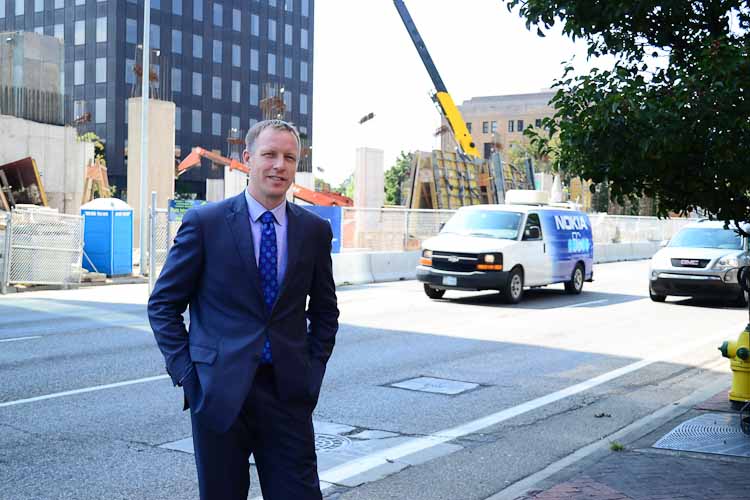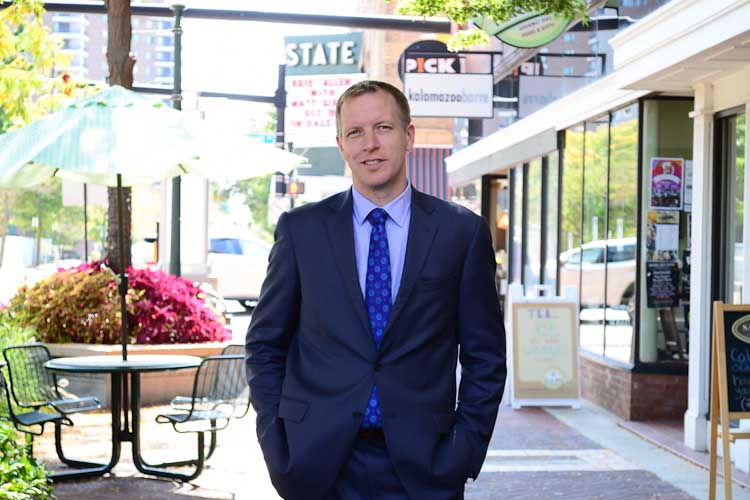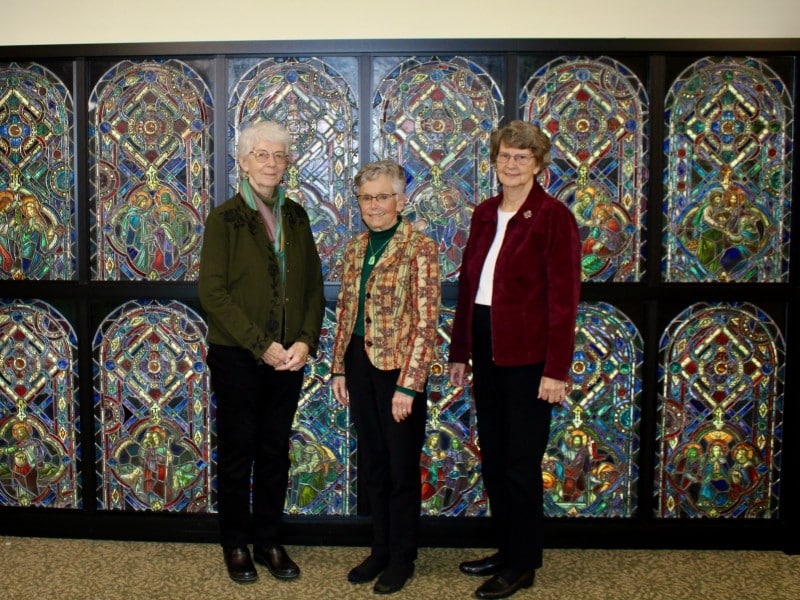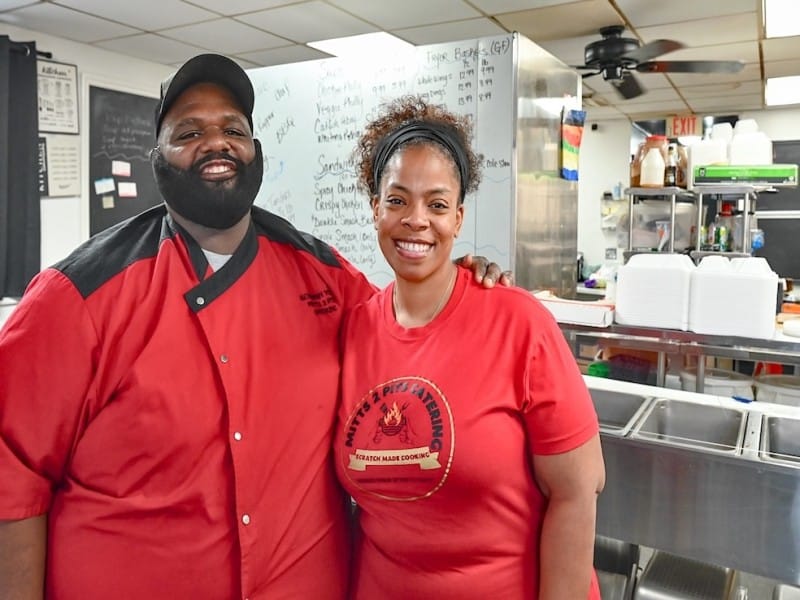Local roots and passion for downtowns serve Downtown Kalamazoo Inc. president well
How this "townie" went from competitive skateboarding to downtown management.
Andrew Haan remembers downtown Kalamazoo life in the early 1980s when he was kid.
“It was so striking — at lunch time the sidewalks were just full of people. By five o’clock it was tumbleweeds.”
In February Haan took his role as the president of Downtown Kalamazoo Inc., the organization that helped boost downtown out of its tumbleweed doldrums. Second Wave visited recently to pick his brains after a busy summer of growth and change downtown.
An active townie
Haan, 40, is a self-proclaimed “townie.”
In his 20s he worked for Piranha Alley on the Kalamazoo Mall and he was a competitive skateboarder before the lure of city management put him in a suit.
But he’s not in a suit all the time. In introducing himself at the DKI boardroom, he points out a long scratch on his neck, from an encounter with a tree when riding the new Maple Hill mountain bike trail. He’ll often bike the KRVT with his wife Allison, towing their four-year-old Gerrit in a trailer, he says. He still can’t resist doing jumps at the K-zoo Skate Zoo.
Haan is born-and-raised Kalamazooan, 5th generation on his dad’s side of the family and 6th generation on his mother’s, with “deep roots here.” He’s a product of the Kalamazoo Public Schools system, Kalamazoo Valley Community College, and Western Michigan University.
His mother’s side of the family were the Warrens, of Warren Sporting Goods. “You can say that downtown retail is in my blood.”
In addition to selling boards at Piranha Alley, Haan worked at the Radisson and various downtown restaurants. He lived in the Skyrise apartments at the time.
Through the ’90s Haan saw downtown grow from tumbleweeds to people on the sidewalks into the night, customers in restaurants, concert-goers at the State Theatre, beer-fans at Bell’s Eccentric Cafe.
The subjects of urban growth and history fascinated Haan.
“I was really captivated by the feeling I got when I was surrounded by old buildings. At the time, I wasn’t sure what it was. I’ve come to realize that a big part of it is that downtowns were built following traditional development patterns that have been around for thousands of years — they were built to human-scale, and not designed solely with cars in mind,” he says.
“These places foster community — you see your neighbors on the street and have happenstance conversations. You spend your money at places you can walk to, and it’s the most efficient and productive use of land. People want this kind of genuine experience, in an authentic place, it’s one of the competitive advantages downtowns have.”
He studied public history at WMU, and went on to earn a Master of Science degree in historic preservation and downtown revitalization from Eastern Michigan University.
Haan became the executive director of Downtown Muskegon Now in 2010, then was the associate director of the Governor’s Office of Urban and Metropolitan Initiatives in 2013.
At his gig working for Gov. Snyder, Haan was based in Kalamazoo, and got some perspective through “exposure to what’s going on throughout the state and beyond,” he says.
“In my four years in that position, I had the opportunity to forge strong relationships across business, municipal, nonprofit, and philanthropic sectors here in Kalamazoo, and when the opportunity to step into the leadership role at DKI presented itself, I took the leap.”
At DKI, what has Haan learned so far?
“I’ve found that there is an incredible amount of support in the community for downtown and for investing and insuring that downtown Kalamazoo remains the strongest part of the community, not just of the city,” he says.
“I’ve also learned that the work never ends. You have to constantly be thinking about what’s next, and you can’t take your foot off of the accelerator.”
Downtown needs “constant movement, constant growth.”
The research in taxable value per acre shows that “downtown is where this community makes its money,” he says.
Downtown is crowded with money-making properties that have “tiny little footprints and are 15 stories tall, and have been there for, in some cases, 90 years.”
But downtown also has properties that bring crowds down to play, shop, learn, and live, he points out.
“We have to be really mindful of how to use our resources, which includes our land, and I think we really do a good job of it in the dense development pattern that we have downtown.”
Commitments to Mall City
When the country’s first pedestrian mall was created in Kalamazoo in 1959, “I think it was a really visionary step, but that trend kind of played out — pedestrian malls never worked to turn around a declining downtown,” he says. KVCC’s Arcadia campus has brought life to Kalamazoo’s mall, he says. Plus WMU’s continued commitment and interest in downtown, and the presence of institutions from Bronson Hospital to Kalamazoo County’s government, all help keep the heart of downtown thriving.
“I think getting those institutional partners into downtown and staying downtown has been critical,” he says. “It’s the big players and the leverage that they bring. All of the people and organizations that are able to orbit around them, I think are important, too. It’s not just the institutional players, but when they pioneer something and make a commitment, it really gives others confidence to invest as well.”
Connecting downtown hotspots
As anyone trying to find parking around Bell’s Brewery or Hopcat on a weekend evening can attest, there’s been what Haan calls “incredible growth” at downtown’s east end.
“There’s still a lot of activity on the mall, and that’s still our core,” he says. “Our challenge and opportunity is to stitch those two areas of activity together. Making sure that East Michigan is a place people are comfortable walking. I mean, it’s three blocks — it’s not far. So how do we make those areas seamless and not seem as far away?”
Kalamazoo needs new ways “to make a better, more-pleasant street that is slower and quieter, and incorporates multiple modes of travel together,” he says. “East Michigan was originally retail blocks, and it doesn’t lend itself to that in the current configuration.”
As a way to improve the walkability of the area, and to expand the popularity of cafe-style outdoor seating for restaurants as seen on the Mall, Haan points to the Bates Alley project. DKI is now crowdfunding to turn the alley behind the restaurants, bars and shops along Michigan between Portage and Edwards Streets into a pedestrian “promenade.”
With outdoor seating, lighting, and accouterments, Haan hopes that “places like Paris might come to mind” for visitors to what is now a strip of parking spots and garbage dumpsters. He would like to see similar developments of underutilized spaces.
More than one way for downtown streets
Haan is making DKI another voice calling for converting Michigan and Kalamazoo Avenues into two-way roads, with improvements for pedestrians and bicyclists.
“Our streets really constrain our ability to stretch some of this retail development beyond the block that the Mall is on. We heard loud and clear at the Imagine Kalamazoo planning process from the community that they really want to see these streets turned back to two-way traffic.”
As they are, the wide, one-way, heavy streams of vehicles “dramatically impair navigability for visitors. And it’s really set up to be a highway… two state highways that are split up into one-way pairs,” — Kalamazoo and Michigan as connections for M-43, and North Westnedge and North Park for the business loop of U.S. 131 — “all geared to move as many cars as fast as possible, and really aren’t set up to serve downtown and serve the community and people who want to be here.”
Haan wants to work with the city and businesses, institutional partners, and MDOT to get a traffic solution “that helps drive more economic growth here.”
It’s proven that one-way streets are limiting downtown’s possibilities, he says. “We have an analysis that shows we could capture an additional $50 million a year in retail and restaurant spending downtown if we fix the streets and had a more progressive parking management policy, and did some other key interventions.”
Declining festivals
It was downtown’s growing entertainment and restaurant scene in the late ’90s that “led us to where we are now,” Haan says.
Part of the growth of that scene was spurred by the Arcadia Creek Festival Place. It was just a parking lot in the ’90s that held a few music and food festivals. The festivals grew and the city turned the lot into a park-like site in 2004. Overseen by DKI, the new Arcadia hosted large festivals that brought people downtown most summer weekends.
But the frequency of festivals dropped steeply over the past couple of years. “I don’t think there’s any doubt that the Festival Place could be programmed more attentively and have a greater impact on downtown,” Haan says.
The cost to rent the site from DKI is one of the complaints that festival organizers have had. “I think we have a fairly reasonable rental fee, but people are right, it is very expensive to produce an event at the festival site,” Haan says, since organizers also have to invest in porta-potties, fencing, security, and more.
DKI has convened a group of leaders from community, residents, concert promoters, and venue managers to “take a hard look at how we leverage the huge investment the community has put in that space already, and capitalize on the warm feelings the community still has.” The group should present its findings in early 2018.
It’s a major goal for DKI to get life back into Arcadia Festival Place, he says. “The site has had a huge impact on the area. It’s exposed many thousands of people to downtown that maybe would not have come were it not for a Greek Fest, Blues Fest, Rib Fest, whatever it may be.”
Downtown life
Haan and his family live west of downtown in the Arcadia neighborhood. “I’m a short, 12-minute bike commute going down hill.”
“We have a four-year-old, and we would like a small yard of some sort. That was not an option downtown.” His choice shows a challenge for DKI and downtown, he says. Downtown has faced demand for residential living, but the choices of homes are limited.
DKI is working on how to broaden the housing options. Haan is thinking there needs to be space for people at all income levels, “brownstones and row-houses and live-work spaces — in some places even tiny houses are a thing.”
Downtown should be an economic powerhouse for the area, but it also should be a neighborhood in which people can live and safely move about, Haan says.
Haan adds that the city needs more infrastructure, sidewalks, safe crossings, and other amenities for car-less travel. He points to the 45 bike racks added over the summer. “With bicycles, in particular, it’s a matter of ‘if you build it, they’ll come.'”
“Walkability is something that’s really critical.” Haan notes that the downtown’s walk score is high, “and there is a direct correlation between walk score and property values.” Right now, a downtown resident “can walk to 90 percent of anything you need.”
“It truly is a neighborhood,” he says.
A neighborhood and a city
“Cities have followed one basic development pattern for thousands of years. And it’s built to the human scale, where you could walk to everything you need. It’s only been in the last 60 years or so that that’s changed. I think we’re starting to see a reversal of that.”
In Haan’s view, downtown Kalamazoo can be a nice place to live, work, and play, as it keeps growing. “We’re the biggest center of commerce, center of employment, in the metro area, and it’s something that we always have to focus on — continued growth. You’re either growing or you’re shrinking. And we can’t just be content and rest on the work we’ve done in the past,” he says.
“We’ve got to be always thinking, what’s next, what’s sustainable, and what’s going to leverage further investment and growth.”
Mark Wedel has been a freelance journalist based in Kalamazoo since 1992. His first driving experience in downtown Kalamazoo was at the age of 17, when, while looking for Boogie Records, he went the wrong way down a one-way street. The city’s roads still provide him with consternation. For more, see his work here.


















